It is almost impossible to overstate the importance of communication in management. Nearly everything managers do to make it easier for their organizations to achieve their goals requires effective communication. If people cannot share information, it is clear that they will not work together, formulate plans and execute those (Missiroli et al., 2016). Communication solves most human resource management problems and improves interactions between people within a team (Beenen et al., 2021). However, communication is a complex process consisting of interdependent steps, and each of these steps is necessary to make thoughts understandable to the other person.
The work aims to study the impact of managers’ communication process on the effectiveness of organization management. It requires the following task: to get acquainted with the nature and complexities of communication, the process, and the potential barriers to understanding the essence of messages. Moreover, it is essential to study the stages of the communication process and how to improve it.
Research Background
The study of communication as an independent field of social sciences began with the evolution of technology. Theoretical communication’ questions originated with cybernetics, computer science, and semiotics (Saraih et al., 2019). In addition, communication is adjacent to ethnography, psychology, and linguistics (Myung-Hee, 2018). Communication science is integrated with other sciences to study communication processes as a structural unit. Communication is the transfer of information from one subject to another. The subjects can be individuals, groups, or entire organizations (Rizescu & Bucata, 2017). Communication is interpersonal by transferring ideas, factors, opinions or perceptions, feelings, and attitudes from one person to another in verbal or non-verbal form to receive the desired reaction in response.
Communication in business processes is the glue that brings employees, departments, and divisions together. Without adequate and aligned communication, it is impossible to get a strategy up and implement a project (Whittaker & Thomas-Medwid, 2016). Rules are necessary for communication to be effective and accepted by all involved (Weiszegger, 2020). Projects should be planned because it allows one to control the execution process. A manager will increase the efficiency of the project by sharing expertise, making decisions, and adjusting progress.
In an organization, communication plays specific roles that enable the effective management of teams. First, communication contributes to determining the level and quality of management decision-making (Saraih et al., 2019). Secondly, they characterize the state of the organization’s internal environment by ensuring the functioning and interaction of people, structure, goals, technology, and objectives of the organization (Rizescu & Bucata, 2017). Thirdly, they create an informal system in the process of functioning of the organization and contribute to the convergence of the formal structure with it.
The study of communication processes and their relationship to team management allows one to determine the organizational aspects of the company. Evaluation of such indicators as the number of employees, meetings, hierarchy, feedback system gives an insight into the internal environment (Markovic & Salamzadeh, 2018). Evaluation of the effectiveness of communication is related to the company’s overall status. In management, there is a coordination of the communication process to achieve high performance.
Thus, there is a need to assess the most critical indicators of the organization’s level and quality of communication. In addition, it is necessary to investigate the impact of communication on the company’s appearance in society. In the study, the author will discuss the types and barriers of communication, reveal the principles of proper interaction, and evaluate internal communication at Apple.
Literature Review
In the broad sense of the word, management activities are the exchange of information, which is the most complex problem in any organization. Communication is a stable connection between the participants in the management process, which includes working with information. (Okoro et al., 2017). It is the connecting link, which allows planning, organization, motivation, and control. The purposes of communication are to organize the joint work of teams, establish the relationship between people in the organization, and exchange information (Sato et al., 2019). In addition, communication allows people to develop an emotional and intellectual exchange of management information and formulate a common perception within the organization. Communication affects the appearance of the organization: consumer demand, employee comfort, and overall strategic goals.
Communication is seen as exchanging information between employees and administration, the enterprise, and the external environment to solve problems. A manager has some information necessary for making effective decisions. Due to communication, a manager brings data to subordinates, who also offer some knowledge for work (Rizescu & Bucata, 2017). It includes work with documents, organization, carrying out business meetings, participating in official events, telephone conversations, electronic correspondence, and the like. In other words, all those parts are needed to imagine the modern business and which the foundations of its effective functioning are.
Communication is also defined as the process by which managers develop a system of providing information, conveying it to many people within the enterprise and individuals or institutions outside of it. According to various studies, managers spend 50-90% of their time on communication (Okoro et al., 2017). They are sometimes compared to the nervous system in the human body: just like all organs are united and depend on the work of the nerves (La Marco, 2019). Communication is the linking process when managers perform their administrative functions and permeate the entire management process.
Communication’ Types
Communication in management is divided into the following types:
- External communication between the organization and the external environment. These include communication, which represent information interaction with the external environment: consumers, suppliers, state regulatory bodies, mass media, etc.;
- Internal communication between levels and divisions in the organization. These include inter-level communication in organizations.
Vertical communication “lower – higher level” is designed to alert higher levels of management to what is happening at lower levels. System “higher-lower level” describes the delivery of information from management to subordinates. This is how the organization’s strategic direction is communicated (Whittaker & Thomas-Medwid, 2016). Horizontal communication exists between different units at the same level of the management hierarchy. They are necessary to achieve coordination of interaction to reach the overall goals. Communication of the type “manager-subordinate” serves to exchange information about the way of activity, work efficiency, remuneration, abilities of employees, problems, changes in the results, opportunities for improvement. Communication between the manager and a specific workgroup are needed to involve a more significant part of the subordinates in the organization’s affairs.
Communication is also divided into formal and informal types of interaction. Formal type is determined by a particular organization’s policies, rights, and job descriptions and is carried out through formal channels. Informal communication does not adhere to the general rules of the organization (Szostek, 2019). It is carried out following the established system of personal relationships between employees of the organization. At the same time, informal channels can transmit reliable information. In this regard, to develop the best managerial decisions, managers must consider the information obtained during informal communication.
Communication is divided into oral and written based on the way it is disseminated. Oral form occurs during personal communication, group discussions, telephone conversations, in which spoken language conveys content. The advantage of oral communication is that they provide immediate feedback and mutual exchange. The disadvantage of oral communication is that it is often unreliable. Typical problems include using the wrong words, lack of information or time.
When choosing a form of communication, managers must consider their advantages and disadvantages. The advantages of written communication are accessibility, reliability, and speed. This type is usually used, when one or both parties need to write a confirmation of what is happening. The disadvantage of written communication can be due to personal characteristics and communication or Internet connection limitations. They are more complicated than oral forms and require more time to prepare. Sometimes the feedback and interchange can be delayed due to them.
Interpersonal communication is also commonly divided into verbal and nonverbal, designed to exchange information without words, such as through gestures, the intonation of voice, and the like. Verbal and nonverbal forms of communication do not permanently exclude each other (Okoro et al., 2017). As a rule, interpretation of the message by the addressee (receiver) is based not only on words but also on such elements as gestures and facial expressions accompanying the words of the transmitting party.
Barriers to Communication
Establishing proper communication involves many issues: the willingness of partners to develop communication, the methods chosen, the identification and removal of obstacles, the appropriate combination of verbal, visual, and written forms (Szostek, 2019). In practice, the effectiveness of communication is reduced if the message is inaccurately formulated. Information can be lost during transmission or storage due to the inattention of workers. In addition, the data may be misinterpreted or incompletely interpreted, so employees will not be able to adapt to it.
A severe obstacle in establishing effective communication is an authoritarian administration attitude to subordinates, unclear performance or unwillingness of managers to perform their duties, insufficiency of positive business atmosphere, and motivation. Researchers also note the improper definition of rights and responsibilities, fear of managers and subordinates’ consequences when transferring too truthful information, and the like. The subjective factors that reduce the effectiveness of contacts between employees include different interpretations of the same concepts when exchanging information. Therefore, there are barriers in data transfer due to its distortion, misunderstanding, and slowing down the process. In addition, the recipients first perceive the information they expect to receive and sometimes ignore the data that does not coincide with their perceptions.
Thus, communication in an organization aims to bring departments and teams together to realize high performance. Communication relates to each member of the company and plays the role of the glue to form a comfortable environment (Markovic & Salamzadeh, 2018). They affect the company’s overall status, employee attitudes, customer demand, and strategic decisions. If managers stop using interpersonal communication, it leads to various barriers and congestion that reduce productivity.
Methodology
This research paper focuses on the impact of interpersonal communication on the organization and overall effectiveness and productivity. To this end, the study set an objective: to identify the most critical factors in the communication process that can negatively affect it and affect the organization. The goal can be achieved by analyzing a case study that reveals aspects of interpersonal communication in the management area of one large organization. For this study, the author will explore Apple, one of the leaders in the global appliances and electronics sales market.
The paper uses a mix of methodological approaches: empirical, statistical, and evidential. Several approaches allow one to consider interpersonal communication on different levels and provide a detailed analysis of the company and its internal environment (Wolf, 2016). There is a concept of scientific management that describes management practices with an emphasis on theoretical components. This term describes an empirical approach to the team’s analysis. The statistical approach analyzes quantitative indicators (revenue, number of employees) and look for correlations between them (Beenen et al., 2021). The evidentiary approach argues that the studied indicators affect the organization’s success and communication.
The object of the study will be Apple, for which the author will consider the indicators affecting interpersonal communication. The analyzed period will cover the last decade because the company has made a real breakthrough in all indicators, including the organization’s internal environment. Moreover, it is relevant for such a large company to consider the impact of competition and why it positively affects the employee organization (Wolf, 2016). Interpersonal communication within the company will be evaluated using the following indicators: number of employees and senior managers; overall organizational structure; working conditions; employee support; information channels; feedback system; status of the company. Based on the results, the author makes conclusions about the effectiveness of interaction between managers and their subordinates and gives some recommendations.
Data Analysis
Apple has been called one of the most comfortable workplaces because it is interested in its employees. It is quite a high score, as it is challenging to organize the internal environment. Society has believed that the company’s success can only neighbor with tight control of employees and a strict corporate structure. However, like other giants of good communication processes, Apple has a well-organized environment and a corporate document reflecting communication principles and the main rules. The company’s main advantage is its pyramid-type reverse communication system, which increases the speed of information transfer and the rapid delivery of new policies. It dramatically increases company productivity and team building, as a level playing field obliges everyone to follow the rules.
One cannot talk about the Apple team as a gray, monotonous mass because the company has an employee rule with a clear function. It means that each employee is in their place and acts according to their department plan. Such a strategy promotes successful organization and clarity of instruction (Bernstein et al., 2016). Researchers have noted that this approach goes a long way toward making employees feel more comfortable in the work environment.
An analysis of the state of interpersonal relationships within the company should begin with the organizational structure and the number of employees involved in the work process. Figure 1 shows that the total number of employees is increasing in proportion to the managers.
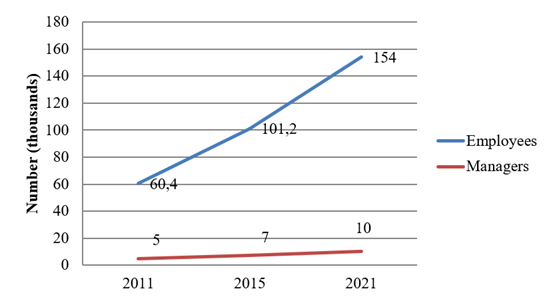
The company’s corporate documents draw attention to the fact that Apple is a well-organized structure whose priority is not the position but the function. In addition, all employees, including the board of directors and senior managers, are subject to the same principles of communication and interaction (Statista, 2021). Thus, it is possible to judge that this segment is fine-tuned in Apple.
The corporate structure of the company and communication channels between functional departments has also been analyzed. According to the organization’s career opportunities document, departments are linked by function, not business (Podolny & Hansen, 2020). The paper’s author refers to the fact that the company is a group of people with a common purpose, not just work and business. In the context of communication interactions, this view significantly increases trust and demonstrates the effectiveness of the corporate mission (Bernstein et al., 2016). Apple is structured as follows: board of directors → senior management → directors and senior vice presidents. All employees are divided into functional departments: marketing, communication, environmental, and others report to Tim Cook (CEO). The departments related to design, interface, and projects report to senior vice presidents. Based on the information obtained, a diagram in figure 2 shows the company’s structure.
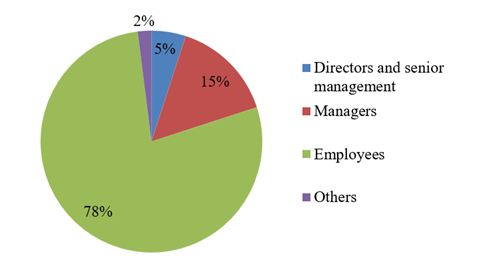
Figure 3 shows that the communication channels in the company are organized like an inverted pyramid and work in both directions.
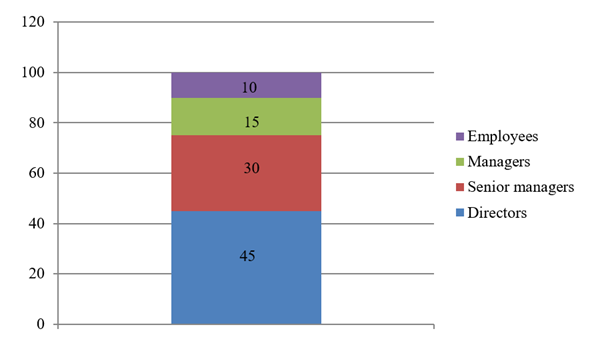
Due to this type of communication, both employees and managers receive prompt and accessible information on time. In this way, new strategic goals flow through all structures and are informed by further details. As a result, employees have specific knowledge and information about their department (Craig, 2018). This is where the principle of functional separation, rather than business, is implemented, and subordination and corporate postulates are preserved. The company gains efficiencies precisely through the complete transfer of information (Podolny & Hansen, 2020). The company’s goal is to develop consumer interest, not sell directly. As one can see, the same rule applies to the internal environment.
As already mentioned, feedback is done in the same way: managers from each department gather information and concentrate it into a single product. Managers then work with experts who evaluate the information and integrate it into the higher departments. This is a simple scheme, but it has allowed Apple to achieve two critical metrics: high salaries for all employees and a high percentage of the trust. Figure 4 shows graphs comparing employee salaries and the trust in the companies.
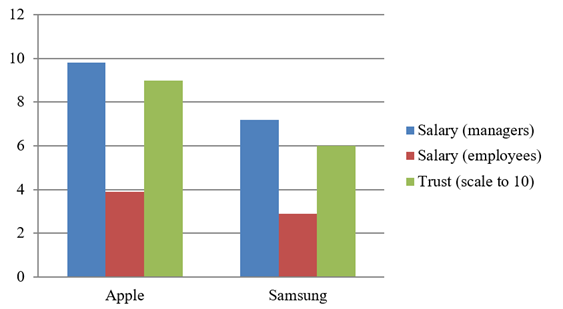
In this way, Apple dramatically benefits from the corporate organization and the overall environment within the company. Corporate directives effectively control business functions and product groups with this organizational structure (Craig, 2018). It facilitates the effective implementation of strategic management and helps with alignment. It can be concluded that the communication processes are set up correctly and positively impact performance dynamics.
Apple has a large profit margin that allows it to offer its employees a favorable working environment and provide functional places to rest and work. The company is known for its fleet, organized by crossover, promoting cross-collaboration. Figure 5 demonstrates a four-part organization of employees to develop capacity.
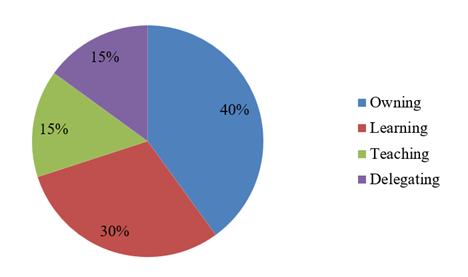
The company believes that such a scheme helps develop the leadership potential of rank-and-file employees and equalizes their status with managers and executives. The company also notes that it would be ideal for keeping a balance and paying attention to all aspects (Apple, 2021a). The dominance of one or the other task can lead to lower productivity and quality degradation. Communication processes with such a scheme promote dynamic development and positively influence attitudes toward work.
Communication, in general, is influenced by employee support programs and career development opportunities. According to data provided by Apple Career, absolutely all employees are open to professional growth, and the main criteria for selection are experience and the desire to innovate (Apple, 2021a; 2021b). The company offers its associates corporate discounts on products, access to all parts of Apple Park, great credit offers, and opportunities for expectant parents. Moreover, the company is committed to diversity: the organization provides workplaces without relying on social stereotypes and tries to match the job to the individual.
Conclusion and Recommendations
Thus, the study contains reliable information about interpersonal communication and its impact on organizations. Communication acts as a link between managers and employees, creating an organized space. Emerging communication barriers are addressed through personal dialogs, meetings, and techniques. Through a comprehensive methodology, the study determined Apple’s communication effectiveness. Apple has positioned itself as a high-performance organization with communication mechanisms between employees and managers to promote a comfortable ecosystem. The company operates on the principle of a reverse communication pyramid, which solves the issue of information transfer between managers and employees and resolves cases of corporate ethics violations through a unified system of feedback.
Communication is essential to any crucial managerial action in such big organizations like Apple. Information must be exchanged between the organization and its environment, between higher and lower levels, and between organizational units (Sato et al., 2019). Managers communicate directly with subordinates, whether they are individuals or groups (Jones & Tynan, 2022). The information exchange in an organization can be improved by creating feedback systems, regulating information flows, taking managerial actions, printing informative materials, and applying advances in modern information technology. Managers can increase the effectiveness of interpersonal exchanges by clarifying ideas before communicating them, considering possible differences, and understanding the meaning of non-verbal language.
References
Apple. (2021a). Job creation. Apple.
Apple. (2021b). Work at Apple. Apple.
Beenen, G., Pichler, S., Livingston, B. & Riggio, R. (2021). The good manager: development and validation of the managerial interpersonal skills scale. Front Psychol., 12. Web.
Bernstein, E., Bunch, J., Canner, N. & Lee, M. (2016). Beyond the Holacracy HYPE. Harvard Business Review, 94, 38-49.
Craig, C. (2018). How Steve Jobs broke down the wall between internal and external communications. Linkedin.
Jones, S., & Tynan, M. (2022). Workout 3: changing your focus – from being customer-driven to problem-solving 360° – from looking outside to looking inside. In 7 Entrepreneurial leadership workouts: A guide to developing entrepreneurial leadership in teams (pp. 49-62).
La Marco, N. (2019). The effects of interpersonal communications in an organization. Chron.
Markovic, R. M., & Salamzadeh, A. (2018).The importance of communications in business management. The 7th International Scientific Conference on Employment, Education and Entrepreneurship.
Missiroli, A., Andersson, J. J., Gaub, F., Popescu, N., & Wilkins, J.-J. (2016). Strategic Communicationss from the east. In Strategic Communicationss: East and South (pp. 7–24). European Union Institute for Security Studies (EUISS).
Myung-Hee, J. (2018). Effects of organizational and interpersonal relations on job satisfaction of social workers. The Journal of Industrial Distribution & Business, 9(6), 25-35.
Okoro, E., Washington, M. C. & Thomas, O. (2017). The impact of interpersonal communications skills on organizational effectiveness and social self-efficacy: A synthesis. International Journal of Language and Linguistics, 4(3), 28-32.
Podolny, J. M. & Hansen, M. T. (2020). How Apple is organized for innovation. Harvard Business Review.
Rizescu, M. A. & Bucata, G. (2017). The role of Communications in enhancing work effectiveness of an organization. Land Forces Academy Review, 22(1). Web.
Saraih, U. N., Azmi, A. H., Sakdan, M. F., Mohd, K. K. & Amlus, M. H. (2019). Understanding the effects of interpersonal communications and task design on job performance among employees in the manufacturing company. Humanities & Social Sciences Reviews, 7(5), 448-453.
Sato, K., Nakamuro, M. & Owan, H. (2019). The effect of interpersonal skills on worker performance. RIETI Discussion Paper Series, 19-T-045.
Statista. (2021). Apple’s number of employees in the fiscal years 2005 to 2021. Web.
Szostek, D. (2019). The impact of the quality of interpersonal relationships between employees on counterproductive work behavior: A study of employees in Poland. Sustainability.
Weiszegger, W. (2020). Management strategy, policy, and compliance. In Implementing the UN management reform: Progress and implications for peace operations (pp. 8-12).
Whittaker, G., & Thomas-Medwid, R. S. (2016). Melissa Fernau: Internal communications manager. Bulletin of the American Meteorological Society, 97(9), 1713.
Wolf, F. (2021). The good and the bad of modern internal communications. Forbes. Web.